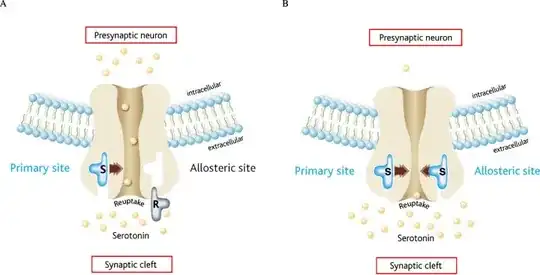Edited
From the therapeutic point of view escitalopram and citalopram are the same; the difference between them resides on the isomers, pharmacologically citalopram is named as R,S-citalopram and escitalopram is named as S-citalopram.
citalopram and escitalopram are selective serotonin reuptake inhibitors (SSRIs) and widely used antidepressants. Citalopram is a racemic mixture, whereas escitalopram is its S-enantiomer. Both agents have similar profiles of clinical efficacy and side effects. PubChem

Binding of R‐citalopram at the allosteric site on the 5‐HT transporter decreases the time that S‐citalopram occupies the primary site. article
Since citalopram is a racemic mixture and being S-citalopram the active ingredient, one might attempt to think that escitalopram that only has S-citalopram to be better or superior, when in fact, in terms of efficiency they are completely the same with escitalopram being prescribed with half the dosage of the citalopram for the same therapeutic effect, but the efficiency remains the same. In terms of potency, escitalopram, indeed, is far much potent than citalopram for that same reason.
Presently, the claims about clinically relevant superiority of escitalopram over citalopram in short-to-medium term treatment of major depressive disorder are not supported by evidence other article

As one can see, the SERT occupancy is practically the same for 5 mg of escitalopram that corresponds to 10 mg of citalopram and also identical for 10 mg of escitalopram that corresponds to 20 mg of citalopram.
Once R‐citalopram can act with a similar mechanism as a competitive antagonist in this case, it is important to remember that those don't affect the Emax, what just happens is that more concentration is needed to achieve the same effect; also, toxicologically, it is possible to exist some differences that might be interesting to note and those be a choice factor between one and the other, however therapeutically there are none, because -kinetically they are very well studied and design to have a proportional response.
Without excluding your research, when we take a closer look, we read things like
A pooled analysis from 4 trials showed a significant superiority of escitalopram versus citalopram,9 and this has been confirmed in a direct comparison of escitalopram and citalopram in severely depressed patients.23
and then we go to articles 9 and 23, and not surprisingly the metrics that they used to use the word [superior] and better "efficacy" was based on MADRS (Montgomery-Asberg Depression Rating Scale) furthermore article 23 aims to conclude this
The MADRS score decreased more in the escitalopram than in the citalopram arm (–22.4±12.9 versus –20.3±12.7; P<0.05)
and by those two points they won the champions league and conclude superiority :) and the story is all the same in all the reports they cite, for instance
There was a significant difference in response between escitalopram and citalopram (56 vs. 41%, respectively, p = 0.007)
Everytime based upon a metrics of MADRS and in this case with a difference of 15%, which is something... but still it doesn't seem enough to call it superior or that has a better efficacy.
Personally I wouldn't go from there, these metrics are very easy to hack and the results are not so upfront as they state.
Regarding your main question "Why does anybody still prescribe Citalopram with Escitalopram available", I'd give you that, is a good question, if I might say so, they both have equivalent efficiencies; with escitalopram being more potent than citalopram; and of course we can't exclude the fact that all the data suggests that the response from escitalopram (based upon the MADRS metrics point of view) is at least slightly better than citalopram, with that being said, that doesn't mean citalopram is obsolete, it can still be a choice of treatment, however if we exclude pharmacoeconomic factors and other realms of realities such as publicity and commissions, that is a very difficult question to answer, because we can choose between one and the other: with one having a slightly better response than the other (according to MADRS metrics), it's a dilemma.
In my opinion they both do the job, if one does it one week earlier or if there is a difference between them of 2 points according to the MADRS protocol, they still are quite equivalent.

